Few Americans are aware that, collectively, they shoulder more than $18 trillion in debt exposure[REF] from loans, loan guarantees, and subsidized insurance provided by some 150 federal programs. While legions of regulators scrutinize the actions of private banks and financiers, there is sparse oversight of the government’s massive credit subsidies and their detrimental effects on the economy. This redistribution of taxpayers’ money erodes the nation’s entrepreneurial spirit, increases financial risk, and fosters cronyism and corruption. It is time to shut it down.
The government credit portfolio consists of direct loans and loan guarantees for housing, agriculture, energy, education, transportation, infrastructure, exporting, and small business, among other enterprises. Federal insurance programs cover bank and credit union deposits, pensions, flood damage, declines in crop prices, and acts of terrorism. Capital for mortgage lending by banks is provided by government-sponsored enterprises (GSEs), such as Fannie Mae and Freddie Mac.
Total outstanding loans and loan guarantees backed by taxpayers exceeded $3.4 trillion at the end of fiscal year (FY) 2015.[REF] Add in the exposure of Fannie Mae, Freddie Mac, the Federal Home Loan Banks (FHLBs), the Federal Deposit Insurance Corporation (FDIC), and the Pension Benefit Guaranty Corporation (PBGC), and the total swells to an estimated $18 trillion.[REF]
Researchers with the Federal Reserve Bank of Richmond, in their “Bailout Barometer,” estimate that 61 percent of all liabilities throughout the U.S. financial system are explicitly or implicitly backed by government (that is, taxpayers).[REF] But the actual liability is greater because federal accounting methods understate the costs. Nor do government balance sheets capture the economic distortions induced by credit subsidies.
Federal credit ballooned amid the 2008 financial crisis. Between November 2008 and March 2012, the government “invested” $187.5 billion in Fannie Mae and Freddie Mac.[REF] Similarly, under the Troubled Asset Relief Program, the government[REF] purchased $540 billion in stock from Ally Financial, Chrysler, General Motors, AIG, and dozens of banks to shift corporate financial risks to taxpayers.[REF] Despite the recession ending in June 2009, higher levels of subsidies have persisted.
With some government loans extending 40 years, the ever-growing burden of federal credit will encumber generations to come—without their consent. Advocates insist that the subsidies are necessary to equalize opportunity, but a variety of other less destructive means of assistance are available.
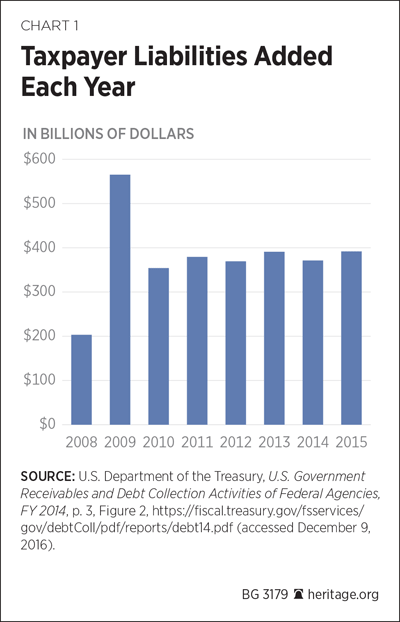
Reform of government financing has not been a congressional priority. Few taxpayers are aware of the extent of the burden, and the subsidies have given rise to powerful constituencies of beneficiaries. And unconstrained spending, unfettered loses, and rampant cronyism are only part of the cost of the government’s vast credit racket. Trillions of dollars of credit subsidies represent the commandeering of financial services by government and its escalating power over private enterprise.
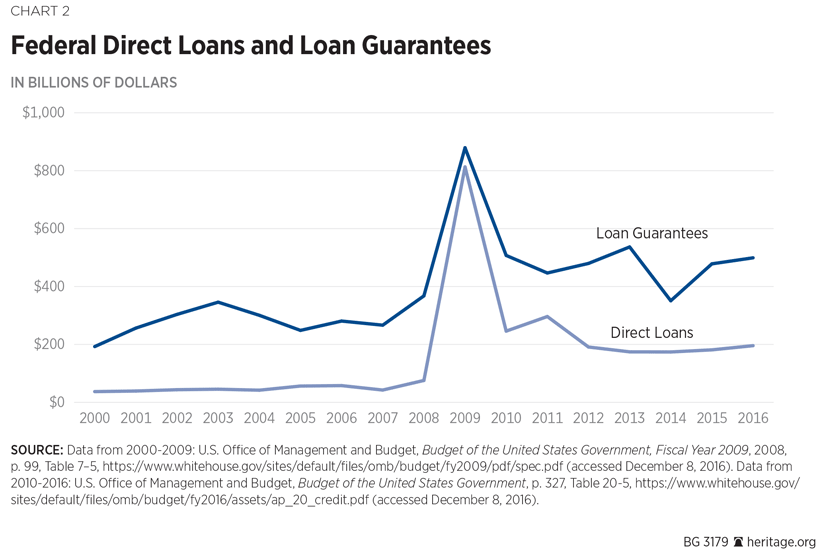
Distortions
Proponents say that government lending is necessary in order to spur economic growth, or to mitigate “market imperfections,”[REF] such as gaps in available financing or lack of competition (leading to unduly high credit costs). But government credit is a poor substitute for private financing. The purposes of the two are entirely different, as are the repercussions.
Private lenders offer credit to generate profit. The challenge they face is to minimize risk and maximize return—within ever-changing market conditions. Under threat of loss (and independent of government meddling), great care is taken in lending decisions.
In contrast, government financing is entirely detached from the profit motive (and its inherent discipline) because tax revenues provide an endless source of capital, and bureaucrats are largely protected from accountability. Losses are dispersed among millions of taxpayers, and are considered to be justified as a cost of reducing access inequities to capital. Consequently, default rates exceeding 20 percent are common among federal credit programs.[REF]
The U.S. Department of Agriculture (USDA), for example, awarded 100 loans totaling $2 billion to deploy rural broadband service. A total of 18 loans defaulted and 25 others were rescinded. Only nine have been repaid. In its evaluation of the USDA’s Rural Utilities Service, the Government Accountability Office concluded that the agency “has not gathered information or performed analyses to better understand what might lead a project to default or otherwise make a project a poor candidate for receiving a loan.”[REF]
Government financing programs are often sold to the public as economic imperatives, particularly during downturns. In reality, they are instruments of redistributive policies, such as “affordable” housing, protection of the “family farm,” and energy “independence.” In many instances, the biggest beneficiaries are those with the most political influence, not those with the greatest need.[REF]
Some subsidies exist largely to serve specific corporations, as is the case of the Export–Import Bank—widely known as “Boeing’s bank.” Ex–Im advocates claim that the finance subsidies are needed to fill gaps in financing for small businesses that cannot attract private capital. But the bank’s foremost beneficiary is Boeing,[REF] the world’s largest aerospace company (with a market cap exceeding $87 billion).
Well-intentioned or otherwise, there is abundant evidence that government financing produces more harm than benefit for the nation as a whole. For one thing, government credit represents a subsidy (either explicit or implicit). Because there is virtually no chance that the government will not cover a loss, federal credit is provided on more favorable terms than financing from a private lender, including:[REF]
- Interest rates below commercial levels,
- Longer maturities than private loans,
- Deferral of interest,
- Allowance of grace periods,
- Waiver or reduction of loan fees,
- Higher loan amount relative to the enterprise value than available from a private lender, and
- Availability of funds for purposes for which the private sector would not lend.
Whether government credit is provided as a loan or loan guarantee, it constitutes a risk borne by taxpayers for the benefit of a private party. That risk—multiplied by tens of thousands of transactions—carries direct and indirect consequences for the nation.
Indeed, when the government shifts credit risk to taxpayers, borrowers are largely relieved of the consequences of failure, and act accordingly. As noted by economist Henry Hazlitt,[REF]
Responsibility follows risk. When an owner’s risk in an enterprise has been minimized or eliminated because the government has supplied the funds which he otherwise would have to supply, then, speaking comparatively, the owner tends to feel no great pain from the failure of the enterprise. He would stand to gain by its success, of course, and so he would tend to work for its success; but his position is an unbalanced one because he will not try desperately to prevent its failure.
When borrowers need not compete for private loans based on merit, productivity improvements and innovation become less important than political capital. Moreover, credit-worthiness also becomes less relevant to banks and mortgage lenders that act as pass-through agents for government financing.
When the Federal Housing Administration (FHA) loan program debuted in 1934, for example, a down payment approaching 50 percent of the purchase price was a common requirement. Last year, more than 72 percent of new FHA loans were financed with less than 5 percent down.
The result is a larger proportion of economic assets (in the form of both property and enterprise) that are inherently weaker than they otherwise would be if financed by private lenders instead of government (taxpayers).
Government financing also distorts the allocation of private lending. As noted by economist Jeffrey Lacker, president of the Federal Reserve Bank of Richmond, “These government lending programs, by targeting particular market sectors, alter the allocation of credit across markets. Consequently, while some market segments benefit from reduced funding costs, others may actually see their costs rise as credit is diverted to those markets that have been targeted for support.”[REF]
There is also a pernicious regulatory chain reaction when government engages in lending. As Hazlitt noted, “[When] the government provides the financing, the private property becomes public property instead and the government has the right to decide how, where, when, and by whom the property shall be used.”[REF]
For instance, there are hundreds of procedures and rules of practice imposed upon depository institutions by the FDIC. Lawmakers devised government deposit insurance in 1933 to restore public confidence in the banking system. But their good intentions also dramatically increased government control of the financial system—sometimes to disastrous result.
Consider the 2008 financial crisis. In 2001, as part of micromanaging bank reserves, regulators assigned a lower risk weight to mortgage-backed securities than to individual (unsecuritized) mortgages. Therefore, banks that converted individual mortgages into mortgage-backed securities did not need to hold nearly as much capital in reserve to cover potential future losses. By freeing up capital, the banks could write more loans and generate more earnings.
No surprise, then, that demand for mortgage-backed securities surged (which also induced banks to increase mortgage lending by lowering standards). Meanwhile, the Clinton Administration pursued explicit homeownership goals, including quotas for lower-to-moderate-income buyers. All of these policies fed the unsustainable housing bubble with higher-risk mortgages—the collapse of which prompted the 2008 financial crisis.
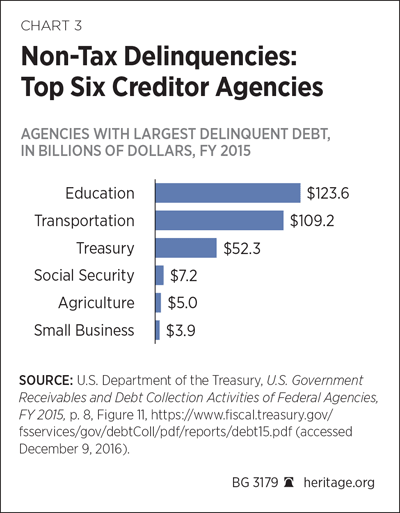
Purported Benefits
Proponents of government credit contend that the social goals for which the subsidies are employed justify—or at least offset—the market distortions, regulatory onslaught, and taxpayer risk they produce.
Whether subsidized financing achieves the goals set by policymakers is dubious; there is very little measurement of program results, and abundant evidence of negative consequences. Under the Government Performance and Results Act of 1993, for example, Congress directed federal agencies to set goals and report on their progress. But the metrics largely measure only inputs (such as the number of loans awarded), not outcomes.
At the very least, any benefit derived from government credit is offset by handicapping enterprises that operate without subsidies.
Tracking Costs
The Federal Credit Reform Act (FCRA) of 1990 requires agencies to estimate the long-term costs (including subsidy costs) of loans and loan guarantees, and to “true up” those figures annually (after the end of the fiscal year) to reflect actual loan performance and to incorporate any changes in projections of future loan performance.
However, the methods required by law to do so produce imprecise results, and, consequently, faulty projections of budgetary gains and losses. There are also inconsistencies among agencies in scoring, and scarce oversight by Congress of payment errors and default rates.[REF]
Under the FCRA, the subsidy cost of federal credit is calculated by first converting all future loan costs and revenue into a “net present value.”[REF] Because $100 to be received a year from now is not worth as much as $100 today (which could be invested now and grow larger over the next year), a discount rate is applied to future revenues when calculating the net present value. Under the FCRA, that discount rate is tied to the interest rate on U.S. Treasury securities.[REF]
If the present value of estimated cash outflows exceeds cash inflows, there is a subsidy cost. If the present value of estimated cash inflows exceeds cash outflows, there is a negative subsidy cost, referred to as “subsidy income.”
However, as currently calculated, subsidy estimates consistently understate costs because of the nature of the discount rate applied when calculating net present value. Treasury yields are lower than private securities because there is virtually no risk that the government will default. This low rate does not account for the actual risks that government loans represent. Therefore, the government’s accounting method produces artificially high estimates of future revenue. (In other words, the lower the discount rate, the higher the present value of future income.) The use of these artificially low discount rates makes government loans appear to generate income for the Treasury.
In some instances, the differences are substantial. For example, the Congressional Budget Office (CBO) estimates that the loan guarantees provided by the FHA for 2014 and 2015 will “save” $16.4 billion. However, employing a more realistic discount rate to the calculation produces a cost to taxpayers of $2 billion for the same set of loan guarantees.
As noted by economist Deborah Lucas, “If you use the price of Treasury securities to try to assign a price to a risky loan, you get nonsense.”[REF]
Inaccurate budget estimates feed the propensity of government to minimize costs, and induce policymakers to expand federal credit rather than adopt other policy tools. All of which increases the risk to taxpayers.
Most agencies have been granted “permanent indefinite authority” to obtain additional funds from the Treasury to cover higher subsidy costs that result from annual re-estimates. That means the actual costs are largely hidden.
How should agencies calculate subsidy costs? The Financial Economists Roundtable recommends that subsidy costs be calculated using the same discount rates as private lenders. Those rates would be higher than Treasury rates, thereby reducing the present value of future income—and thereby providing a more accurate estimate of the costs to taxpayers.
According to Lucas, “Private-sector financial institutions are responsible for reporting fair values [of loans and guarantees], so there is an entire infrastructure for providing these values.”[REF]
Major Credit Programs
The following section describes several forms of government financing for which taxpayers are liable, either explicitly or implicitly. An expanded list of programs by agency can be found in the Appendix.
Federal Deposit Insurance Corporation
- Deposit Insurance Fund Balance: $72.6 billion
- FDIC Insured Deposits: $6.4 trillion
Between 1930 and 1933, some 9,000 banks failed, prompting Congress to create the FDIC as an independent agency under the Glass–Steagall Act.[REF] The idea was to restore confidence in the banking system by offering government-guaranteed deposit insurance and requiring all state and federally chartered banks to carry coverage.
The FDIC covers the following individual accounts:
- Checking accounts;
- Money market/savings accounts;
- CD accounts;
- Revocable trust accounts;
- Irrevocable trust accounts;
- Employee benefit plan accounts;
- Corporation, partnership, or unincorporated association accounts; and
- Government accounts.[REF]
FDIC insurance does not cover stocks, bonds, mutual funds, life insurance policies, annuities, or securities.
Originally, deposits were insured for up to $2,500 per depositor, per insured bank, for each account ownership category. That limit remained unchanged for some 16 years, and increased rapidly beginning in the 1970s.
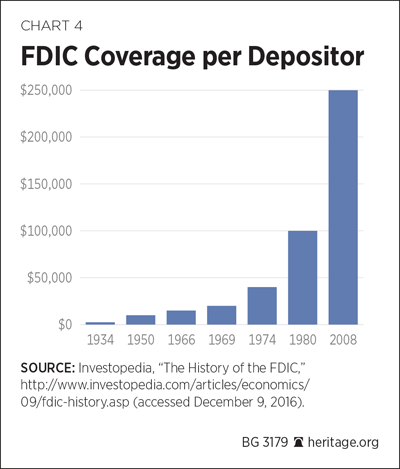
The FDIC funds coverage by collecting premiums from banks and investing the funds in securities. It is also authorized to borrow from the U.S. Treasury.
When a bank fails, the FDIC reimburses depositors either by providing each with a new account at another insured bank in the amount allowed under coverage limits or by issuing checks to depositors.
The FDIC also functions as the receiver of the failed bank, and assumes responsibility for managing the assets and liabilities that remain. Depositors may recover a portion of uninsured funds from the sale of bank assets.
The FDIC’s fund balance totaled $72.6 billion at the end of 2015, which constitutes a reserve ratio of 1.09 percent.[REF] The Dodd–Frank Act raised the minimum Designated Reserve Ratio to 1.35 percent (from 1.15 percent), and removed the upper limit on the maximum reserve ratio (which had been capped at 1.5 percent).[REF]
There is no plausible scenario under which all insured banks would simultaneously fail and require a vastly larger fund. However, as noted in the FDIC’s 2015 annual report, “Projections for the [Deposit Insurance Fund] are subject to considerable uncertainty.” Higher interest rates, slower economic growth, and errors in earnings projections may stress the fund, potentially foisting another bailout on taxpayers.
The very design of the program is actuarially unsound. Flat-rate premiums are set by Congress without regard to an institution’s risk of failure. Likewise, coverage is provided regardless of bank management. Political pressure keeps premiums artificially low, which means that taxpayers are shouldering risk that ought to be covered by the banks. Moreover, the likelihood of failure is heightened by banks’ inclination to take more risks when potential losses will be covered by taxpayers.
Whether the nation needed the FDIC in 1933 is debatable,[REF] but there certainly is little reason for it to exist today, when a variety of financial instruments are available to hedge banks’ risks. Good intentions notwithstanding, creation of the FDIC dramatically increased government control of the financial system to protect taxpayers’ liability.
To try to offset some of that risk, the FDIC plays a major role in bank regulation as a monitor, a supervisor, and an enforcer of hundreds of rules. These functions were expanded with the 2010 passage of Dodd–Frank, which extended the agency’s regulatory authority to bank holding companies with more than $50 billion in assets and to non-bank financial companies that are designated as “systemically important” by the Financial Stability Oversight Council.
To the extent that the FDIC has assumed the role of guardian, banks have relied on regulatory requirements as safe harbors—despite the government’s dismal record on forecasting risk. For example, federal regulators have long imposed risk-based capital requirements on banks to mitigate potential losses. But as noted above, regulators contributed mightily to the 2008 financial crisis when they guessed wrong about the degree of risk relative to investments they deemed to be safe.
Pension Benefit Guaranty Corporation
- Outstanding Obligations: $108 billion
- Total Deficit: $76.4 billion (2015)
Following the failure of several pension plans in the 1960s and 1970s,[REF] Congress enacted the Employee Retirement Income Security Act (ERISA). The law granted tax benefits to employers who contribute to pensions, and exempted pension payments from workers’ calculation of taxable income.
ERISA also established the Pension Benefit Guaranty Corporation (PBGC) to insure the pension benefits of workers and retirees in defined-benefit pension plans. The PBGC operates two insurance programs: single-employer plans and multiemployer plans.[REF] About 31 million people are covered under single-employer plans, and 10 million by plans in the multiemployer program.
In 2015, the maximum annual payment guaranteed under the single-employer program was $60,136 for a retiree at age 65.
Taxpayers are not explicitly responsible for backing the pensions, but there is an implicit guarantee that the federal government (taxpayers) will intercede if insolvency threatens.
The PBGC’s total liability in FY 2015 hit $108 billion, representing 4,706 single-employer pension plans that have “terminated” (plus five probable terminations), and $54 billion for multiemployer obligations. The CBO reports that multiemployer defined-benefit plans have committed to $850 billion in benefits, but hold assets worth only $400 billion.[REF] The program is projected to become insolvent in 2025, and some analysts expect that to happen even sooner, particularly if pension failures exceed current estimates or the PBGC’s investment returns lag current forecasts.[REF]
In other bad news, the American Legislative Exchange Council recently reported that state and local governments have set aside only 35 cents for every dollar of pension promises—amounting to $5.6 trillion in unfunded liabilities.[REF]
Premiums for federal pension insurance are paid by participating companies, and supplemented by investment earnings and pension assets assumed by the PBGC. Unlike private insurers, federal law does not allow the PBGC to deny insurance coverage to a defined-benefit plan or to adjust premiums according to risk.
Both types of PBGC premiums—the flat rate (a per person charge paid by all plans) and the variable rate (paid by some underfunded plans) are set in statute—as are myriad exceptions that virtually guarantee underfunding. That means, of course, that taxpayers are shouldering risk that ought to be covered by unions and employers, and the likelihood of failure is heightened by their lack of accountability for failure.
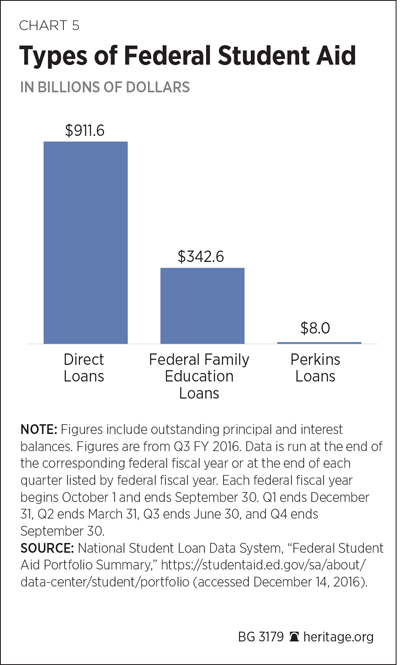
A major part of the problem is the tendency for pension plans to exaggerate investment earnings to project solvency. When those investments fail to deliver on the unrealistic returns, the liabilities shift to the PBGC. But the PBGC itself does not include a risk adjustment in its estimates of investment returns, meaning that it essentially assumes that the returns will match its estimates. The PBGC’s looming insolvency is prompting some lawmakers to propose a bailout—which is alarmingly predictable these days.
Education
- Annual Loan Level: $155 billion (2015)
- Loan Default Rate: 16 percent
- Delinquencies: $123.6 billion
The single largest proportion of outstanding government credit is direct loans to students by the Department of Education. At a total of $1.3 trillion, the loans are now the largest form of non-mortgage debt for U.S. households, according to a report by the Federal Reserve Bank of New York.[REF] In the third quarter of 2016, 16 percent of borrowers—and 10 percent of outstanding dollars—were in default.[REF]
The Department of Education administers three types of direct loans for higher education:[REF] (1) Federal Direct Subsidized Stafford Loans; (2) Federal Direct Unsubsidized Stafford Loans; and (3) Federal Direct PLUS Loans. The loans are distributed to more than 6,000 colleges and universities which, in turn, disburse the funds to students. In addition, some 1,500 schools participate in the Federal Perkins Loan Program, which serves students of “exceptional financial need.” The school acts as lender and services the low-interest loans.
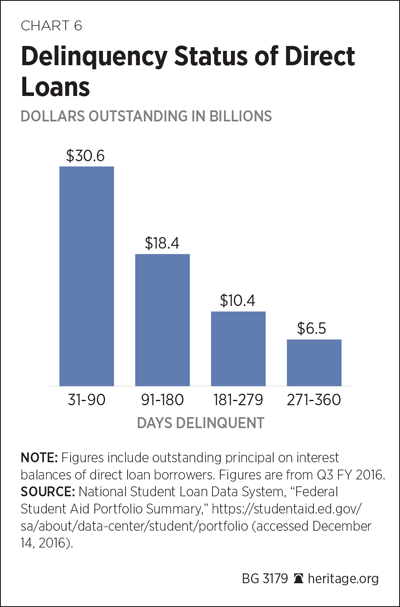
Interest rates on direct loans are adjusted annually based on Treasury rates, and the rate is fixed for the life of the loan. Repayment plans vary by type of loan and the borrower’s income. The Obama Administration in 2011 capped monthly payments at 10 percent of discretionary income, down from 15 percent previously. Any balance remaining after 20 years is “forgiven,” five years earlier than the time frame established by the Bush Administration.
Student lending more than doubled between 2001 and 2012, with some 90 percent of loans originating under federal student aid programs. No wonder: Federal law requires financial aid officers to encourage students to exhaust government borrowing before seeking a private loan. Loose eligibility standards and subsidized interest rates induce students to maximize their borrowing without careful consideration of the consequences the debt load will have on their future finances.
The surge in federal lending appears to drive up tuition disproportionately. When taxpayers subsidize the cost of higher education, colleges and universities need not worry as much about losing enrollment due to tuition costs. Indeed, average tuition rose 46 percent (in constant 2012 dollars) between 2001 and 2012, from $6,950 to $10,200.[REF] As noted by economists with the Federal Reserve Bank of New York, the tuition hikes undermine the benefits of subsidized lending.
While one would expect these [student aid] expansions to improve the recipients’ welfare, for example, through lower interest payments and a relaxation of borrowing constraints, they may have actually resulted in lower welfare because of the sizable and offsetting tuition effect.[REF]
Housing. The federal government now dominates mortgage lending. Various agencies, including the FHA, the Department of Agriculture, and the Veterans Administration, provide mortgage assistance, while institutions such as Fannie Mae and Freddie Mac and the FHLBs influence the availability of mortgage credit in the market. Hundreds of regulations unleashed by Dodd–Frank dictate the terms and conditions of mortgage financing.
The Federal Housing Administration.
- Insurance Portfolio Total: $1.1 trillion
The FHA insures mortgage loans, which translates into lower risk for lenders and thus lower loan costs for borrowers—and big subsidy costs for taxpayers. As of September 30, 2015, the FHA’s primary insurance portfolio included 7.6 million loans with an unpaid principal balance exceeding $1.1 trillion.[REF]
The FHA insured nearly 22 percent of all single-family mortgages originating in 2015, with a dollar volume of $233 billion.[REF]
The FHA loan guarantees are available for a variety of purposes beyond home purchase, including home improvement, reverse mortgages, and loans for repair or construction of apartments, hospitals, and nursing homes.[REF]
Congress created the FHA under the National Housing Act of 1934 in response to the Depression-era collapse of the banking system. Its original mission was to stimulate home construction to create jobs, not to increase homeownership among low-income and moderate-income households as is generally believed.[REF]
Borrowers pay monthly fees to provide lenders with FHA loan-loss coverage. The premiums are based on the size of the mortgage, the term of the loan, and the down payment. Unlike private insurance, FHA fees do not represent the actual risk—and taxpayers are liable for the difference. In FY 2012, for example, the FHA required several billion dollars from taxpayers to cover deficits in the mortgage insurance fund.
There are no income eligibility standards for FHA assistance, which is contrary to basic economic principles that would normally guide lending decisions. More than 72 percent of new FHA loans last year were financed with down payments of less than 5 percent, and as low as 3.5 percent of the purchase price. And, the amount of coverage is tied to the median home price in a region, not income, which can range from $271,400 in Maine’s Hancock County to a high of $721,500 in Honolulu.
The risk to taxpayers is supposedly mitigated by the statutory requirement that the FHA maintain a capital reserve—although the U.S. Treasury is obligated to cover losses that exceed the reserve. The required reserve is just 2 percent of outstanding liabilities—compared to the 4 percent minimum typically required of private insurers. As with other government finance programs, the FHA subsidies constitute a competitive disadvantage to private companies.
For all the costs to taxpayers and entrepreneurs, FHA assistance has not been found to contribute much to boosting homeownership rates. Instead, research indicates that it may accelerate home purchases by a few years. In other words, the FHA enables home purchases by people who could not afford it without taxpayers’ backing.[REF]
Fannie Mae and Freddie Mac.
- Outstanding Debt and Securities Guarantees: $5.1 trillion
Prior to 2008, Fannie Mae[REF] and Freddie Mac[REF] operated as GSEs[REF] whose mission was to provide liquidity for residential mortgage loans.[REF] (Their missions were later expanded to include promotion of “affordable housing.”[REF]) Providing liquidity has entailed purchasing mortgages from banks and then bundling the loans for sale as securities, thus generating bank revenue for more mortgages. The GSEs finance the purchase of mortgages and mortgage portfolios through debt issued in the credit markets. The combined debt and guarantees for mortgage-backed securities held by Fannie Mae and Freddie Mac totaled $5.1 trillion as of November 30, 2015.
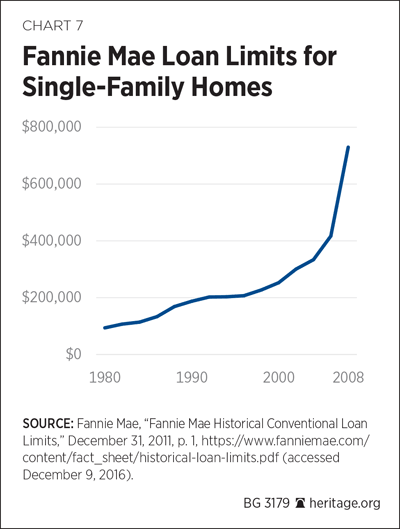
Before 2008, Fannie Mae and Freddie Mac were not explicitly backed by the “full faith and credit” of the federal government (taxpayers). However, the GSEs held a line of credit with the U.S. Treasury, and most investors believed that Washington would not allow either one to become insolvent. Consequently, investors and regulators alike deemed GSE debt and mortgage-backed securities to be virtually risk free, prompting their widespread use.[REF]
The perception of low risk also allowed Fannie Mae and Freddie Mac to borrow at lower interest rates than private investors. The lower cost of risk meant that the GSEs could purchase riskier mortgages—which, in turn, prompted lenders to write riskier mortgages.[REF] These policies also diverted investment into the housing sector from other areas of the economy. By raising loan limits and offloading of risk to taxpayers, Fannie and Freddie created higher demand, thus helping to fuel a housing bubble.
At the peak of the housing market in 2006, the national Case-Shiller home price index was 84 percent above its long-term trend, according to Heritage Foundation financial analysts Nobert Michel and John Ligon.[REF] As the market collapse ultimately proved, the dramatic increases were not sustainable.
When housing prices collapsed and millions of mortgages went bad, the two GSEs were forced into federal conservatorship by the Federal Housing Finance Agency (FHFA). In all, the taxpayer bailout totaled $187 billion.
It is long past time for Fannie and Freddie to be privatized. However, as with most subsidies, special interests are loathe to lose their government favors. Thus, homebuilders, bankers, and “affordable housing” advocates resist reform despite the onerous burden on taxpayers.
Agriculture
- Annual Loan Level: $10.6 billion (2015)
- Outstanding Receivables: $111.6 billion
- Default Rates: <1 percent–75 percent
- Delinquencies: $5 billion
U.S. agriculture policy is a multibillion-dollar tangle of subsidized loans, loan guarantees, and price supports. The outsized “safety net” is essentially an income guarantee. But dramatic changes in the agricultural landscape render Depression-era farm policies wholly obsolete.
The USDA administers more than 29 loan programs, including operating loans, ownership loans, microloans, guaranteed loans, targeted loans, youth loans, loans for minorities and women, tribal loans, loans for beginning farmers, specialty loans, emergency loans, and conservation loans. The loan guide for the Farm Service Agency alone runs 74 pages.
Farming is risky, to be sure, but so are many entrepreneurial endeavors. There also are rewards to balance the hardships. Government policies that cushion farmers invite risk-taking by shifting the costs of failure to taxpayers.
Advances in agronomy, biotechnology, pest control, and disease management have profoundly reduced risks and improved productivity. Yields per acre of staples, such as corn, soy, wheat, and cotton, have doubled, tripled, or quadrupled in a matter of decades. Farm-sector equity hit a record high of $2.6 trillion in 2014, and is forecast to reach $2.47 trillion this year.[REF] Net farm income is expected to hit $66.9 billion, down slightly from a record high in 2013.[REF] There is no justification for continuing to give tens of billions of dollars to the agriculture industry.
Farmers already have a variety of private-sector options to mitigate agriculture risks, including futures contracts and hedging, crop diversification, credit reserves, and private insurance. There could be even more options if Washington loosened its grip on agriculture and allowed entrepreneurs to create new products and services for managing risk.
Many people assume that farm assistance largely benefits “family farms.” While some smaller operations do receive major subsidies, the big winners are large agricultural enterprises. The top 15 percent of all farmers receive about 85 percent of all farm-subsidy payments, according to economist Vincent Smith.[REF] And, the subsidies collected by large enterprises make it more difficult for small farms to stay in business.
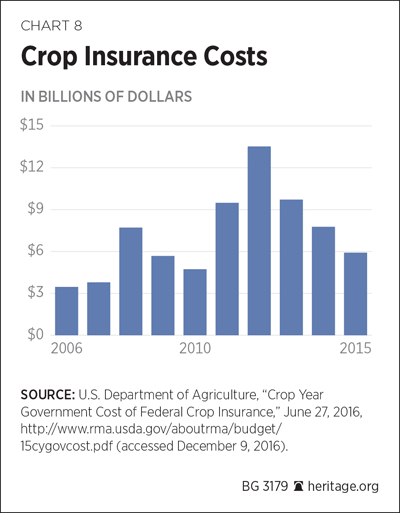
Farm subsidies produce a perverse double-whammy: Taxpayers are hit with underwriting the costs, and consumers are slammed with higher prices on groceries. Meanwhile, rather than stabilizing crop prices as proponents claim, subsidies promote overproduction and downward pressure on prices—thereby increasing subsidy payouts. Moreover, billions of dollars lavished on farmland conservation encourages overplanting on marginal lands that require more chemical management.
Crop Insurance. Federal crop insurance originated in the 1930s, when severe drought and erosion left farmers impoverished. But what started as a hedge against natural disaster has morphed into a huge taxpayer subsidy for wealthy farmers.
Insurable commodities include major field crops such as wheat, corn, soybeans, cotton, peanuts, and rice, as well as many specialty crops (including fruit, tree nut, vegetable, and nursery crops), pasture, rangeland, forage crops, and prices and operating margins of the livestock industry.[REF]
The CBO estimates that the cost to taxpayers for subsidizing crop insurance will reach $8.8 billion per year over the next decade. Indeed, crop insurance is among the most heavily subsidized insurance schemes shouldered by taxpayers. Taxpayers subsidize a whopping 62 percent of the premiums for participating farmers.[REF] Despite paying the bills, the public is prohibited from knowing which farms receive payouts.
Crop insurance policies cover individual farm losses in yield, crop revenue, or whole-farm revenue. Payouts do not require a disaster or catastrophic loss.[REF] There are no limits on the indemnities that farmers can receive.
By law, crop insurance must be provided to all who apply. But shielding farmers from the consequences of their actions encourages risk-taking, including the cultivation of marginal acreage (requiring greater use of water and chemicals).
The insurance is administered by 18 banks designated by the government, which pays fees for servicing the coverage. The program is effectively a cartel in which the government controls the private-crop-insurance market in collaboration with its approved companies. Any new insurance product must receive government approval.
As with other subsidies, crop insurance disproportionately benefits large agribusinesses. According to the Environmental Working Group, the top 10 percent of commodity-payment recipients between 1995 and 2014 collected 77 percent of commodity payments.[REF]
In 1980, Congress greatly expanded the federal crop-insurance program in order to replace a standing disaster-payment program. The expansion of the federal crop-insurance program was seen as an alternative way to provide disaster protection for farmers, which would reduce costs and address moral hazard (parties taking on risky practices because they do not incur the risks). The program has been a complete failure, particularly when looking at costs: The disaster assistance that Congress deemed to be too costly in 1980 was replaced with a crop-insurance program that is six times greater in costs, adjusted for inflation.
The notion that subsidized crop-insurance protects farmers from serious unforeseen losses is largely a myth. In reality, the federal crop-insurance program does not require a disaster or even losses in yield for farmers to receive indemnities. Although promoted as an alternative to the costly disaster payment program, crop insurance subsidies have instead morphed into price supports.
Small Business Administration
- Unpaid Principal 2016 (loan guarantees): $118 billion
- Unpaid Principal 2016 (direct loans): $145 million
- Unpaid Principal 2016 (disaster loans): $6 billion
- Default Rates: 4.9 percent to 27.9 percent
The Small Business Administration (SBA) provides loan guarantees for starting, maintaining, and expanding small businesses. The SBA also provides direct loans to cover the uninsured costs of disaster recovery. Congress created the agency in 1953 to mitigate the supposed tendency of banks to withhold loans from small businesses presumed to pose high risks.
Whether small businesses actually lacked access to private capital at that time, it does not appear to be a problem now. The National Federation of Independent Business reports that obtaining short-term or long-term loans rank among the 10 least-severe problems out of 75 choices.[REF]
On the other hand, the top three most severe problems (out of 75) are the cost of health insurance, unreasonable government regulation, and federal taxes on business income. In other words, small businesses need tax and regulatory relief much more than they need subsidized loans.
The SBA subsidies are a poor substitute for private capital for at least two reasons: (1) they benefit only a fraction of small businesses, which means that other firms suffer a competitive disadvantage, and (2) SBA loan guarantees go primarily to businesses that have been judged to be poor risks by private investors, which means that taxpayers are subsidizing weak enterprises. Not every small business has the potential to succeed—which explains, in part, why the SBA default rates run high.
As is often the case with subsidies, the SBA has been sloppy in handling taxpayers’ money. According to the SBA’s Inspector General (IG), the agency needs to improve quality control in its loan centers, that is, verifying and documenting compliance with loan processing requirements. As the IG noted,
“[I]mprovement is needed for SBA to continue to demonstrate that all elements of the program are being completed and that the program is effective at identifying and correcting material deficiencies.”[REF]
The SBA guarantees 75 percent to 85 percent of the value of loans made under the flagship subsidy program, and these loans are widely regarded as a subsidy to banks. Borrowers apply to an SBA-certified bank. The banks then boost their earnings by selling the government-guaranteed portion of the loans on a secondary market. Ironically, the biggest banks do the most business through the SBA.
Export–Import Bank
- Total Exposure: $102.2 billion[REF]
The Ex–Im Bank was incorporated in 1934 by President Franklin D. Roosevelt to finance trade with the Soviet Union. Congress later constituted the bank as an independent agency under the Export–Import Bank Act of 1945.
The bank provides loans and loan guarantees as well as capital and credit insurance to “facilitate” U.S. exports. The financing is backed by the “full faith and credit” of the U.S. government.
Multinational corporations have attracted the largest proportion of Ex–Im financing, including the construction and engineering firm Bechtel, ranked by Forbes as the fourth-largest privately held company by revenue, and Lockheed Martin, valued in excess of $50 billion. But the bank’s foremost beneficiary is Boeing, the world’s largest aerospace company (with a market capitalization exceeding $91 billion).
These and the other deals with titans of industry belie claims that the bank is necessary to fill “gaps” in financing—that is, bankrolling deals that supposedly pose too much political or economic risk to garner private capital. In fact, U.S. exports in 2014 set a record for the fifth consecutive year, reaching $2.35 trillion—reflecting no shortage of private export capital.[REF]
Supporters say the bank carefully manages risk; its charter allows loans only to enterprises that demonstrate “a reasonable assurance of repayment.” However, Ex–Im’s IG has noted insufficient policies to prevent waste, fraud, and abuse. According to the IG, the bank has also exhibited “weaknesses in governance and internal controls for business operations.”
In another review, the Government Accountability Office reported that the bank appeared to rely on inappropriate risk modeling that could produce inaccurate estimates of both subsidy costs and potential losses.
These findings are not surprising. Ex–Im officials are not putting their own money at risk and thus have less of a stake in the outcome. It is an inevitable aspect of government intrusion into the finances of private enterprise.
Bank officials and advocates emphasize that Ex–Im financing creates jobs. In fact, the bank does not count jobs related to its projects but simply extrapolates numbers based on national data. This formula does not distinguish among full-time, part-time, and seasonal jobs. It also assumes that average employment trends apply to Ex–Im clients (who may not be typical).
Most important, the bank does not account for what would occur in the absence of the subsidies. Ex–Im officials assume that the economic activity they subsidize would not occur absent bank financing. That is an absurd notion, but it is prevalent among bureaucrats who cannot fathom that business actually functions without them.
To the extent that Ex–Im does finance deals that the private sector supposedly snubs, taxpayers are justified in questioning whether they should be saddled with risk that private investors deem unacceptable. It is also difficult to reconcile bank officials’ assertions that they alone assist higher-risk exporters but still manage to offer competitive rates and generate profits.
National Flood Insurance
- Outstanding Debt: $23 billion
- Coverage in Force: $1.2 trillion
Subsidized flood insurance is provided through the National Flood Insurance Program (NFIP), which is administered by the Federal Emergency Management Agency. The insurance is available to homeowners and businesses in communities that adopt and enforce prescribed floodplain management measures.
At the end of FY 2015, more than $1.2 trillion in coverage (5.1 million policies) was in place across 22,100 communities. Private insurers sell and service the policies on behalf of the government and receive generous fees for doing so—fees that consume more than a third of all premiums.
Virtually all flood insurance is issued by the federal government under the National Flood Insurance Act of 1968. Intended to reduce federal disaster payouts, the subsidies have actually promoted development in flood zones and thus worsened the devastation of natural disasters.
Like most government giveaways—well-intended though it was—the NFIP is financially unsustainable, with a debt to taxpayers of $24 billion and counting.
Five federal agencies recently issued a Joint Notice of Proposed Rulemaking to implement reforms adopted in the Biggert-Waters Flood Insurance Act of 2012. Among other things, the act requires mortgage lenders to accept certain private flood-insurance policies rather than requiring coverage under the NFIP. The act also established a multiyear phase out of premium subsidies for commercial properties and vacation homes, and for primary residences after ownership changes.
—Diane Katz is a Senior Research Fellow for Regulatory Policy in the Thomas A. Roe Institute for Economic Policy Studies, of the Institute for Economic Freedom, at The Heritage Foundation.
Appendix: Federal Credit Programs by Agency
Loans
Agriculture
- Agriculture Credit Insurance Fund
- Farm Storage Facility Loans
- Apple Loans
- Boll Weevil Eradication Loan Program
- Distance Learning, Telemedicine, and Broadband Loans
- Rural Electrification and Telecommunications Loans
- Rural Telephone Bank
- Rural Housing Insurance Fund
- Rural Economic Development Loans
- Rural Development Loan Program
- Rural Community Facilities Program
- Rural Business and Industry Program
- Rural Water and Waste Disposal Program
- Rural Community Advancement Program
- Public Law 480
- Title I Food for Progress Credits
- Multifamily Housing Revitalization Program
- Rural Microenterprise Investment Program
Commerce
- Fisheries Finance
Defense–Military Programs
- Military Housing Improvement Fund
Education
- Federal Direct Student Loan Program
- Temporary Student Loan Purchase Authority
- College Housing and Academic Facilities Loans
- Historically Black Colleges and Universities
- TEACH Grants
Energy
- Advanced Technology Vehicle Manufacturing Fund
- Title 17 Innovative Technology Fund
Health and Human Services
- Consumer Operated and Oriented Plan
- Consumer Operated and Oriented Plan Program Contingency Fund
Homeland Security
- Disaster Assistance
Housing and Urban Development
- Green Retrofit Program for Multifamily Housing
Interior
- Bureau of Reclamation Loans
- Bureau of Indian Affairs Direct Loans
- Assistance to American Samoa
State
- Repatriation Loans
Transportation
- Alameda Corridor Loan
- Transportation Infrastructure Finance and Innovation
- Railroad Rehabilitation and Improvement Program
- Highway Infrastructure Investment, Recovery Act
Treasury
- GSE Mortgage-Backed Securities Purchase Program
- Community Development Financial Institutions Fund
- Troubled Asset Relief Program Direct Loan
- Troubled Asset Relief Program Equity
- Small Business Lending Fund
Veterans Affairs
- Veterans Housing Benefit Program Fund
- Native American Veteran Housing
- Vocational Rehabilitation Loans
Environmental Protection Agency
- Abatement, Control, and Compliance
International Assistance Programs
- Foreign Military Financing
- U.S. Agency for International Development, Micro and Small Enterprise Development
- Overseas Private Investment Corporation, OPIC Direct Loans
- IMF Quota 4
- Loans to the IMF Direct Loan Program
- Debt Reduction
Small Business Administration
- Business Loans
- Disaster Loans
Other Independent Agencies
- Export–Import Bank Direct Loans
- Federal Communications Commission
- Loan Guarantees
Agriculture
- Agriculture Credit Insurance Fund
- Agriculture Resource Conservation Demonstration
- Biorefinery Assistance
- Commodity Credit Corporation Export Guarantees
- Rural Electrification and Telecommunications Loans
- Rural Housing Insurance Fund
- Rural Business and Industry Program
- Rural Community Facilities Program
- Rural Water and Waste Disposal Program
- Rural Community Advancement Program
- Rural Energy for America
- Rural Business Investment Program
Commerce
- Fisheries Finance
- Emergency Steel Guaranteed Loans
- Emergency Oil and Gas Guaranteed Loans
Defense–Military Programs
- Military Housing Improvement Fund
- Defense Export Loan Guarantee
- Arms Initiative Guaranteed Loan Program
Education
- Federal Family Education Loan Program
Energy
- Title 17 Innovative Technology Fund
Health and Human Services
- Heath Center Loan Guarantees
- Health Education Assistance Loans
Housing and Urban Development
- Indian Housing Loan Guarantee
- Title VI Indian Guarantees
- Native Hawaiian Housing
- Community Development Loan Guarantees
- FHA-Mutual Mortgage Insurance
- FHA-General and Special Risk
- Guarantees of Mortgage-Backed Securities
Interior
- Bureau of Indian Affairs Guaranteed Loans
- Bureau of Indian Affairs Insured Loans
Transportation
- Maritime Guaranteed Loans (Title XI)
- Minority Business Resource Center
Treasury
- Air Transportation Stabilization Program
- Troubled Asset Relief Program
- Troubled Asset Relief Program, Housing Programs
Veterans Affairs
- Veterans Housing Benefit Fund Program
International Assistance Programs
- U.S. Agency for International Development
- Development Credit Authority
- Micro and Small Enterprise Development
- Urban and Environmental Credit
- Assistance to the New Independent States of the Former Soviet Union
- Loan Guarantees to Israel
- Loan Guarantees to Egypt
- Loan Guarantees to Middle East and North Africa
- Overseas Private Investment Corporation, OPIC Guaranteed Loans
Small Business Administration
- Business Loans
Other Independent Agencies
- Export–Import Bank Guarantees
This report is part of Prosperity Unleashed: Smarter Financial Regulation. Government policies have—for decades—empowered regulators to manage private risks and mitigate private losses in an effort to prevent financial-sector turmoil from spreading to the rest of the economy. This approach, rarely contemplated in nonfinancial industries, has demonstrably failed. Prosperity Unleashed: Smarter Financial Regulation provides solutions to the core regulatory problems that existed in U.S. financial markets long before the 2008 financial crisis.


